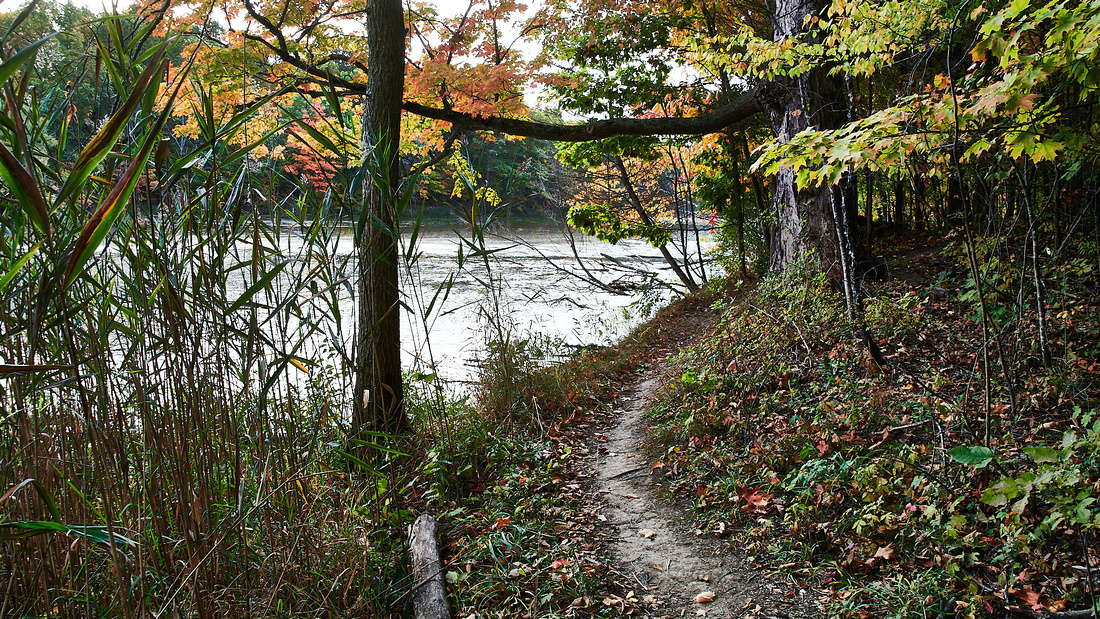First Carolinians
“But indeed, it is not so much for its beauty that the forest makes a claim upon men’s hearts,
as for that subtle something, that quality of the air, that emanation from the old trees,
that so wonderfully changes and renews a weary spirit.”*


The Chair of the writing group at Arts and Letters recently suffered a harrowing loss and has temporarily (we all hope) stepped away. In his stead, our de facto chief gave us the following assignment:
Go for a walk in the forest. Preferably one you’ve never before visited. Write about your experience. Describe what moved you or inspired you.
I’m guessing there will be lots of coloured leaf rhapsodies.
Sometimes, experiencing something familiar through fresh eyes is every bit as intriguing as a brand new experience. That was my goal for this walk through our splendid Carolinian Forest. Me? I’m usually looking down for wildflowers or up for birds. On all my forest hikes I’ve spent precious little time actually looking at the trees. But not this time.
Our Carolinian Forest is enormous and life-giving - it produces most of the oxygen inhaled here in Essex County and, in the heart of it, is Wheatley Provincial Park, Ontario’s “deep south park”. The forest is an ecosystem ‘built’, primarily, of deciduous, native tree species - Tulip Tree, (Liriodendron tulipifera), Shagbark Hickory (Carya ovata), Eastern Cottonwood (Populus deltoides), Sweet Chestnut (Castanea dentata), Sassafras Tree (Sassafras albidum) and Black Gum (Nyssa sylvatica).
Already - after only a mere handful of visits - one of the forest trails at Wheatley is becoming a favourite. It runs, for a stretch, along a creek-fed pond, home to many species of waterfowl, amphibians, reptiles, insects and birds so it was bound to become a favourite. Drifting along that trail, going deeper and deeper into the quiet bethel, I noticed something of a woodland marvel - an enormous Tulip Tree. I’ve dubbed her Tatiana, but unlike Shakespeare’s monarch, mine is Queen of the Trees. Ohmigosh, y’all, she’s a real beaut, measuring close to one hundred feet tall with a diameter of more than three feet. Her canopy stretches wide, better to protect as much of her forest as possible. She cradles all of the forest’s species in her embrace. Fanciful? Maybe. She is very close to the pond and, ‘though today was the first time I paid her any attention, I’ve leaned on her a few times, better to steady myself whilst shooting.
Tatiana is now my mandala. Mandalas are symbols of the universe or wholeness in Buddhism and are often representative of one’s spiritual path. Today I went for a hike in the forest and ‘found’ my mandala.
Wandering through the forest, I was able to identify a few, very old (original, perhaps), Shagbark Hickories that are totemic of the Carolinian Forest. Spying a big, dry, clean rock (a rarity, believe you me!) I sat down to look around the forest, wanting to identify as many tree species as possible. I wanted to notice how each one looked, ‘fully dressed’, before they are naked for their winter’s rest. What I saw was a most disorderly forest, natural, unmanaged and uncultivated. It was the best kind of mess; no rewilding required here.
On this glorious autumn day, Mother Nature exhaled and it would be impossible to miss the unique, herbal scents of this most handsome of forests — that emanation from the old trees, that so wonderfully changes and renews a weary spirit. The air was steeped in the fragrance of the aromatic trees, the organic smell of fallen leaves, and the musky scent of perennials retreating into winter mode. And, of course, the damp smell of decay. All emblematic of transitioning forest life.
Perched on that rock, the seeds of curiosity sprouted and with them came a host of new questions and new possibilities. Chief amongst those questions is, Why don’t I know more about native trees? Next project! So much to learn, so much to experience. Happily, I have the time to cultivate this knowledge and use it in the forest. Sometimes, experiencing something familiar through fresh eyes is every bit as intriguing as a brand new experience.
But indeed, it is not so much for its beauty that the forest makes a claim upon men’s hearts, as for that subtle something, that quality of the air, that emanation from the old trees, that so wonderfully changes and renews a weary spirit.
On a very rare occasion, I make an instinctual and profound connection with something and so it was during this hike, in Wheatley’s preponderant Carolinian forest. I ‘met’ Tatiana and immediately sensed that she would become my mandala - a true, woodland, thaumaturgic experience.
’Til next time, y’all…
*Robert Louis Stevenson from “Morality” in his anthology Essays of Travel. Stevenson, a Scot, was a poet, author and travel writer.
Notes:
The Carolinian Zone (new to me this year) is described as everything south of an imaginary line that would connect Grand Bend (on Lake Huron) to Toronto. The northern part of this zone — which encompasses Toronto, Mississauga, Oakville, Burlington, Milton, Cambridge, Guelph, Kitchener, Waterloo, Woodstock, and London — is mostly an urban sector. The Carolinian Forest, located at the southern tip of Ontario, is unique to the north shore of Lake Erie, an area known as Ontario’s “Deep South”. It is entirely new to me and has captivated my attention and curiosity. The region is biodiverse and more than five hundred (yup 500+) of its species are considered rare and threatened.